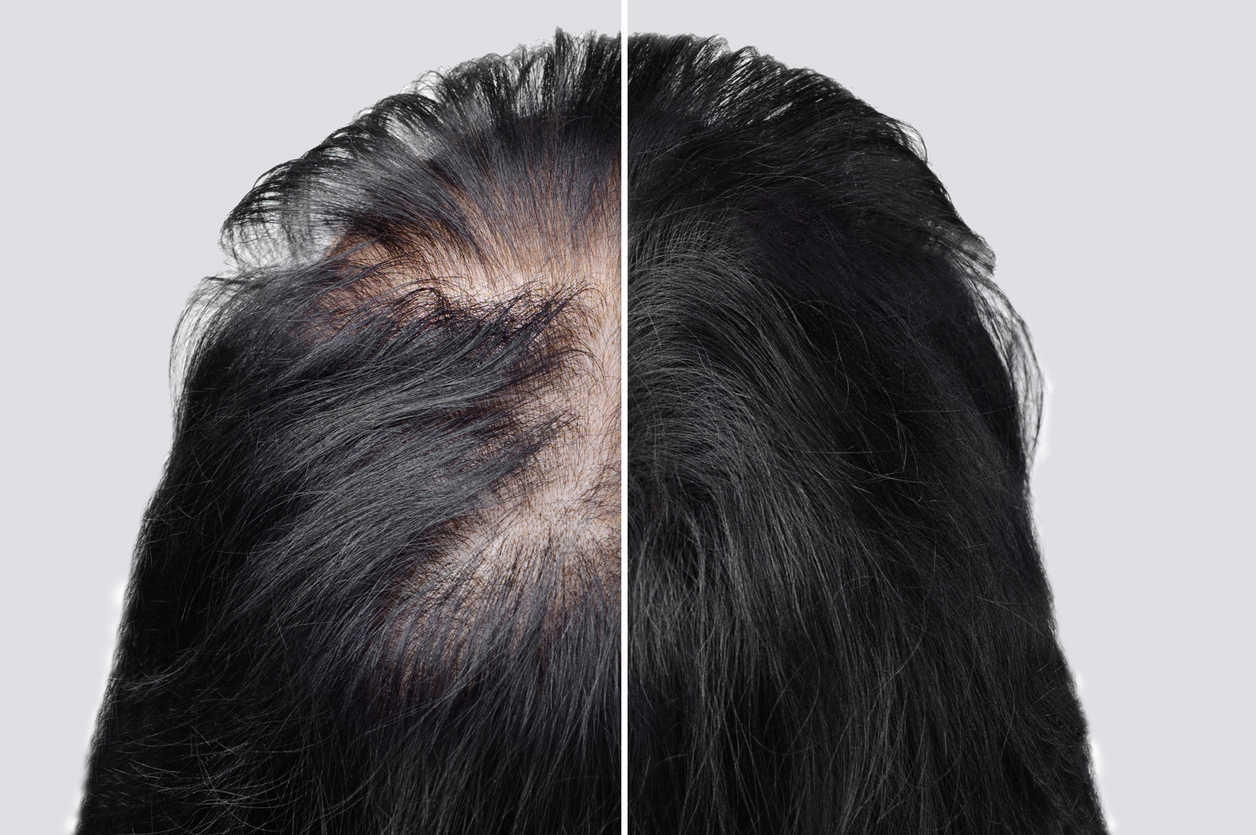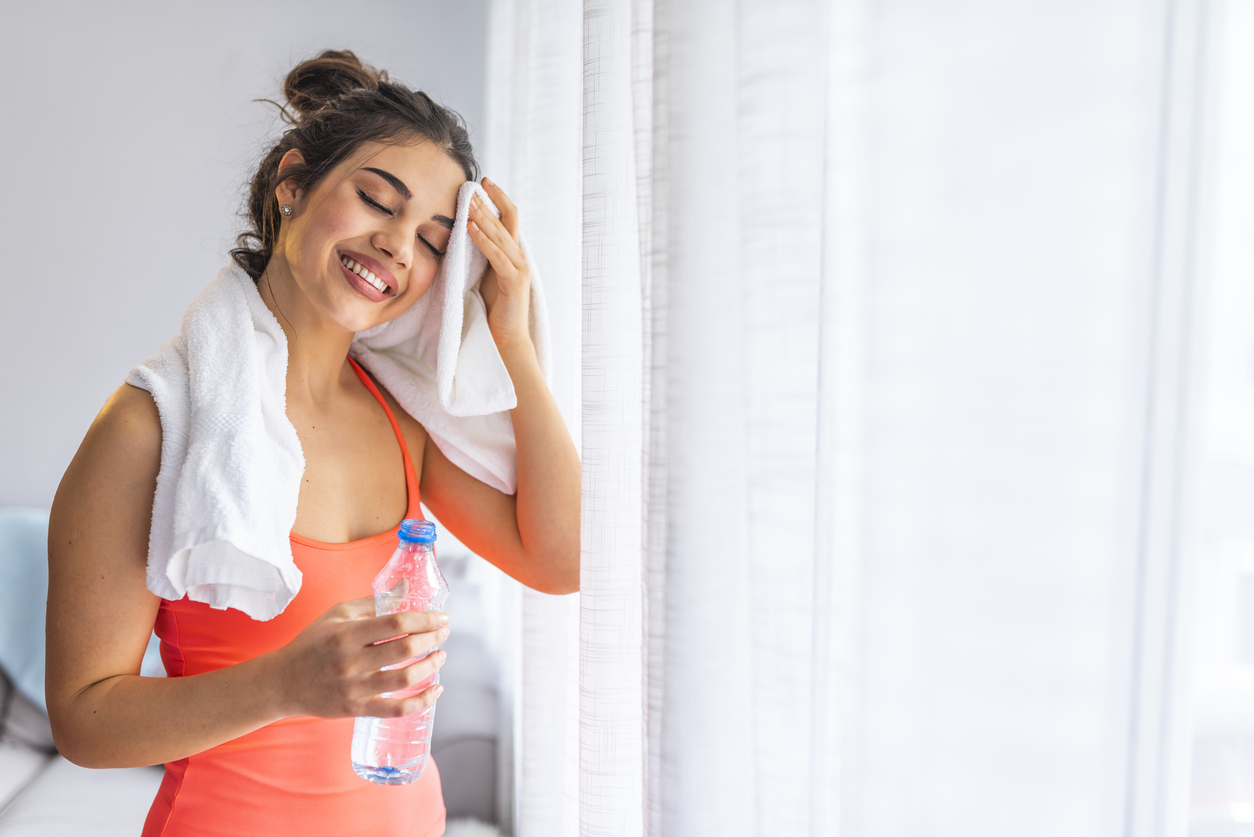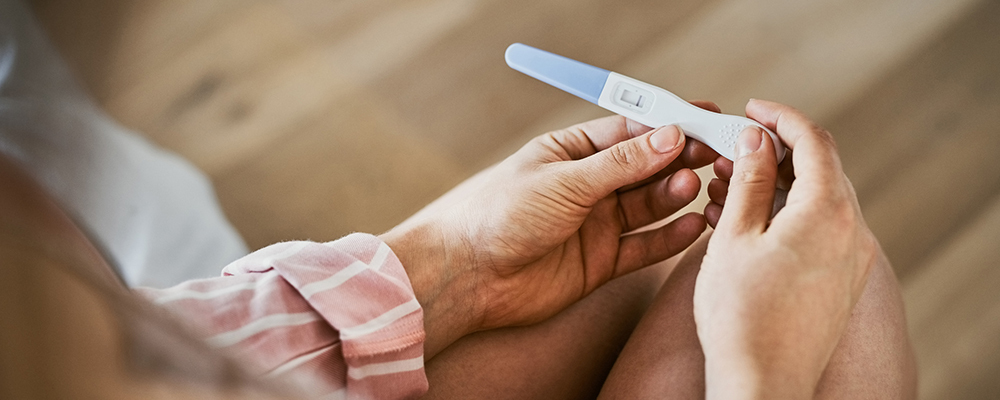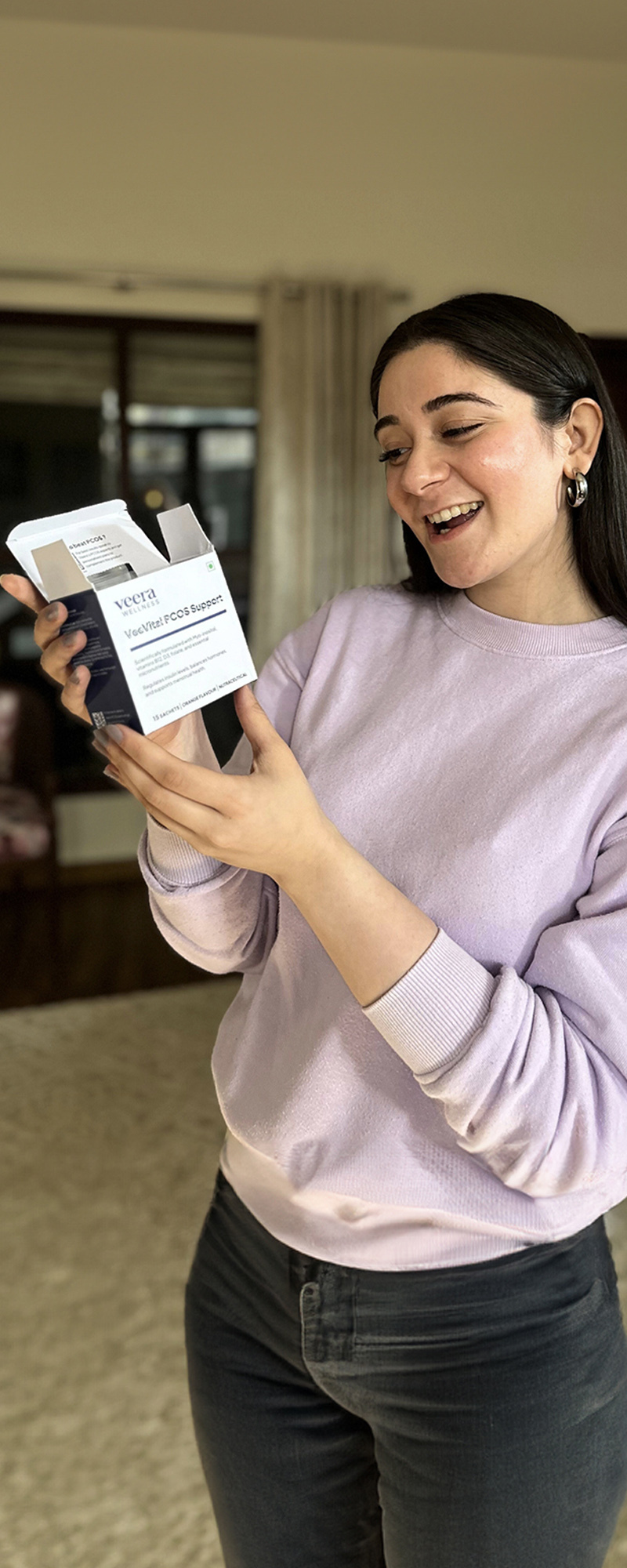Approximately one-third of women experience hair loss (alopecia) at some point in their lives, with up to two-thirds of postmenopausal women facing hair thinning or bald spots. Hair loss often has a greater impact on women than on men due to its lower social acceptability. Alopecia can significantly affect a woman’s emotional well-being and quality of life.
For both women and men, the primary type of hair loss is androgenetic alopecia, also known as female (or male) pattern hair loss. In men, this condition typically starts with hair loss above the temples, leading to a receding hairline that forms an “M” shape, and thinning at the top of the head, often resulting in baldness. In women, androgenetic alopecia begins with gradual thinning along the part line, progressing to diffuse hair loss radiating from the top of the head. Women’s hairlines rarely recede, and complete baldness is uncommon.
Various factors can contribute to hair loss in women, including medical conditions, medications, and physical or emotional stress. If you notice unusual hair loss, it’s essential to consult your primary care provider or a dermatologist to determine the cause and appropriate treatment. Additionally, consider seeking a referral to a therapist or support group to address any emotional challenges. Although hair loss in women can be frustrating, increasing resources are available to help manage and cope with the issue.
What is Male Pattern Baldness in Women?
The National Centre of Biotechnology Information surveyed that, about 20–30% of Indian women experienced hair thinning or severe hair loss in 2020; this frequency increased after menopause. Almost every woman eventually experiences some degree of female pattern hair loss. This condition can begin any time after puberty, but it often becomes noticeable around menopause when hair loss typically increases. The risk of hair loss rises with age and is higher for women with a family history of hair loss on either side.
As the name suggests, androgenetic alopecia involves the action of androgens—hormones essential for normal male sexual development that also play significant roles in both sexes, including sex drive and hair growth regulation. This condition may be inherited and involve multiple genes. It can also result from underlying endocrine issues, such as the overproduction of androgens or an androgen-secreting tumor on the ovary, pituitary, or adrenal gland. In either case, the alopecia is likely related to increased androgen activity. However, unlike in men, the exact role of androgens in female androgenetic alopecia is harder to determine.
In both sexes, hair loss from androgenetic alopecia occurs due to a genetically determined shortening of anagen, the hair’s growing phase, and a lengthening of the interval between shedding a hair and starting a new anagen phase. This delay means it takes longer for hair to begin growing back after it sheds as part of the normal growth cycle. Additionally, the hair follicle undergoes changes, shrinking and producing shorter, thinner hair shafts—a process known as “follicular miniaturization.” As a result, the thicker, pigmented, longer-lived “terminal” hairs are replaced by shorter, thinner, non-pigmented hairs called “vellus” hairs.
A clinician diagnoses female pattern hair loss by taking a medical history and examining the scalp. They will observe the pattern of hair loss, check for signs of inflammation or infection, and order blood tests to investigate other possible causes of hair loss, such as hyperthyroidism, hypothyroidism, and iron deficiency. Unless there are signs of excess androgen activity (like menstrual irregularities, acne, and unwanted hair growth), a hormonal evaluation is usually unnecessary.
Life Cycle of a Hair
Each hair develops from a follicle—a narrow pocket in the skin—and goes through three phases of growth:
- Anagen (A): The active growth phase, lasting two to seven years.
- Catagen (B): The transition phase, lasting about two weeks, during which the hair shaft moves upward toward the skin’s surface, and the dermal papilla (the structure nourishing the cells that give rise to hair) begins to separate from the follicle.
- Telogen (C): The resting phase, lasting around three months, culminating in the shedding of the hair shaft.
Causes of Male Pattern Baldness in Women
Female pattern baldness is primarily a genetic condition, inherited from either parent. These genes make hair follicles more responsive to androgens, or male sex hormones, which everyone has, including females. Androgens play a crucial role in regulating the hair growth cycle, which consists of four phases:
- Anagen phase: Hair grows.
- Catagen phase: Hair growth slows.
- Telogen phase: Hair rests.
- Exogen phase: Hair falls out.
Androgens can shorten the anagen phase, leading to hair becoming shorter and thinner over time.
Factors Contributing to Female Pattern Hair Loss
Menopause:
Female pattern baldness is more common after menopause. During perimenopause, estrogen levels decline, suggesting that estrogen may stimulate hair growth or protect against hair loss. This theory is still under research, as scientists continue to study estrogen’s role in the hair growth cycle.
Childbirth:
Another period when female pattern hair loss may occur is after childbirth, likely due to lower estrogen levels during this time.
Hormonal Imbalances:
Certain medical conditions that cause hormonal imbalances can contribute to female pattern hair loss. For example, polycystic ovary syndrome (PCOS) causes higher levels of androgens in females, leading to hair loss despite being a condition that also causes excessive hair growth. A 2020 study found that 10.5% of women with female pattern hair loss also had PCOS.
Other Causes of Hair Loss in Females:
– **Nutritional Deficiencies:** Deficiencies in nutrients like iron, zinc, protein, and biotin can lead to hair loss. Iron deficiency is particularly common in women, especially during pregnancy or due to heavy periods.
– Stress: Intense or prolonged stress can contribute to hair loss, which can typically reverse within 6 to 9 months if the stress is managed.
– Traction Alopecia: Hairstyles that pull the hair tightly or harsh chemical treatments can cause hair loss.
– Scalp Infections or Skin Conditions: Conditions like psoriasis or scalp infections can inflame the area, leading to hair loss.
– Thyroid Disease: Thyroid issues can cause hair thinning and, if untreated, noticeable hair loss.
– Sexually Transmitted Infections (STIs): Some STIs, such as syphilis, can cause hair loss if left untreated.
– Alopecia Areata: This autoimmune disorder causes the immune system to attack hair follicles, leading to hair loss.
– Medical Treatments: Certain medications, such as chemotherapy drugs, can cause hair loss as a side effect, though hair typically regrows once treatment stops.
Treatment Options
Treatment for female pattern baldness can help prevent future hair loss and may promote some hair regrowth. The options include:
Minoxidil
Minoxidil is a topical treatment applied to the scalp daily. It may stimulate hair growth and prevent further thinning. However, it can take 4 to 6 months of regular use to produce visible results. Side effects can include an initial period of hair shedding, skin irritation, or dryness. Hair loss may return if the treatment is discontinued.
Finasteride
Finasteride is an oral medication that can be taken alone or in combination with topical minoxidil. The effectiveness of finasteride in women is uncertain, and it is not suitable for those who may become pregnant, as it can affect fetal development.
Spironolactone
Spironolactone is a common oral medication for female pattern hair loss. It is an antiandrogen drug that can cause side effects such as:
– Irregular periods
– Dizziness
– Headache
– Rash
– Growth of fine, silky, light-coloured hair on the face
– High potassium levels
These side effects often improve on their own over time.
Light or Laser Therapy
Laser or red light therapy is another treatment option. Devices for low-level light therapy (LLLT) can be purchased over the counter for home use or obtained through professional treatments. A 2020 review found that LLLT significantly increased hair density and diameter. Some users reported minor side effects like scalp irritation, itchiness, or a warm sensation, but these typically resolved after the treatment ended. While there is evidence supporting LLLT’s effectiveness, some studies have potential biases due to industry affiliations.
Hair Transplant
Hair transplants involve moving healthy hair from one part of the body to the scalp. This method is effective but requires a sufficient amount of donor hair. Results can take 6 to 9 months to become visible, though it may take up to a year for full effects to be seen.
Hair Care Practices
Since female pattern hair loss is primarily genetic, it is not always preventable. However, certain steps can help maintain hair health and possibly slow the progression of hair loss:
– Wash hair gently: Use a mild shampoo and conditioner to avoid stripping hair of natural oils.
– Use detangling spray: Apply a detangling spray or leave-in conditioner before brushing to minimize breakage.
– Limit heat exposure: Use the lowest setting on hair dryers and reduce the use of straighteners, curling irons, and other heat-styling devices.
– Avoid chemical treatments: Minimize the use of chemical treatments such as perms or relaxers that can damage hair.
– Eat a balanced diet: Ensure your diet includes sufficient calories, protein, vitamins, and minerals to support hair health.
– Quit smoking: If you smoke, consider stopping to improve overall hair health.
Diet and Nutrition
Eating a nutritious diet can also support normal hair growth. A balanced diet should include a wide variety of foods, particularly an array of vegetables and fruits. These provide essential nutrients and compounds that are beneficial for maintaining healthy skin and hair.
Iron levels can play a significant role in hair health. Women experiencing hair loss should consult a healthcare professional for a blood test to check for iron deficiency. If needed, they may recommend consuming an iron-rich diet or taking an iron supplement.
Coping with Male Pattern Baldness
For some individuals, hair loss can be deeply distressing and impact their self-esteem, potentially leading to:
– Depression
– Relationship issues
– Work-related problems
– Poor sleep
– Avoidance of social activities
If hair loss is causing you distress, consider speaking with your doctor or seeking counseling from a psychologist. While losing hair at a young age can be concerning, hair loss is a common reality as people age. A 2018 study found that up to 75% of women experience hair loss from androgenetic alopecia by the age of 65.
Many people accept hair loss as a natural part of aging. Some choose to wear head coverings or wigs to cope with hair loss, while others opt for shorter haircuts that can make thinning hair less noticeable.
Learn More With Veera
Veera Health, a leading organization in PCOS management, also offers comprehensive therapy and counseling sessions. Understanding the emotional and psychological impact of PCOS, Veera Health provides tailored mental health support to its clients. Their expert therapists and counselors work closely with individuals to address stress, anxiety, and other mental health issues associated with PCOS. These sessions are designed to complement the medical treatment plans, ensuring a holistic approach to managing the condition. With a focus on improving overall well-being, Veera Health’s counseling services help clients navigate the challenges of PCOS. Their integrated care model supports both physical and emotional health, empowering individuals to lead healthier, more balanced lives.




















